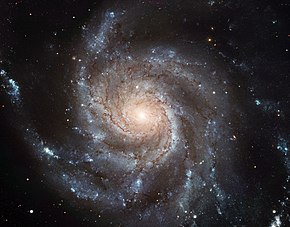
Back Vuurwielsterrestelsel Afrikaans مجرة دولاب الهواء Arabic Galaxa espiral M101 AST NGC 5457 Azerbaijani M101 (аб’ект Месье) Byelorussian M101 BE-X-OLD M101 Bulgarian Galaksienn ar Vilinig Breton Vjetrulja (galaksija) BS Galàxia del Molinet Catalan
| Pinwheel Galaxy | |
|---|---|
 The Pinwheel Galaxy, as taken by Hubble Space Telescope | |
| Observation data (J2000 epoch) | |
| Constellation | Ursa Major |
| Right ascension | 14h 03m 12.6s |
| Declination | +54° 20′ 57″ |
| Redshift | 0.000804 |
| Heliocentric radial velocity | 241 ± 2 km/s |
| Distance | 20.9 ± 1.8 Mly (6.4 ± 0.5 Mpc) |
| Apparent magnitude (V) | 7.9[1] |
| Characteristics | |
| Type | SAB(rs)cd |
| Number of stars | 1 trillion (1012) |
| Size | 51.91 kpc (169,300 ly) (diameter; 25.0 mag/arcsec2 B-band isophote)[2][3] |
| Apparent size (V) | 28′.8 × 26′.9 |
| Other designations | |
| Messier 101, M101, NGC 5457, UGC 8981, PGC 50063, Arp 26 | |

The Pinwheel Galaxy (also known as Messier 101, M101 or NGC 5457) is a face-on, unbarred, and counterclockwise spiral galaxy located 21 million light-years (6.4 megaparsecs)[5] from Earth in the constellation Ursa Major. It was discovered by Pierre Méchain in 1781[a] and was communicated that year to Charles Messier, who verified its position for inclusion in the Messier Catalogue as one of its final entries.
On February 28, 2006, NASA and the European Space Agency released a very detailed image of the Pinwheel Galaxy, which was the largest and most detailed image of a galaxy by Hubble Space Telescope at the time.[10] The image was composed of 51 individual exposures, plus some extra ground-based photos.
- ^ "Messier 101". SEDS Messier Catalog. Archived from the original on 2 September 2023. Retrieved 30 April 2022.
- ^ De Vaucouleurs, Gerard; De Vaucouleurs, Antoinette; Corwin, Herold G.; Buta, Ronald J.; Paturel, Georges; Fouque, Pascal (1991). Third Reference Catalogue of Bright Galaxies. Bibcode:1991rc3..book.....D.
- ^ NASA Content Administrator, ed. (31 May 2012). "The Pinwheel Galaxy". NASA. Retrieved 4 March 2017.
- ^ "NED results for object MESSIER 101". NASA/IPAC Extragalactic Database. Retrieved 2006-12-06.
- ^ a b Shappee, Benjamin; Stanek, Kris (June 2011). "A New Cepheid Distance to the Giant Spiral M101 Based on Image Subtraction of Hubble Space Telescope/Advanced Camera for Surveys Observations". Astrophysical Journal. 733 (2): 124. arXiv:1012.3747. Bibcode:2011ApJ...733..124S. doi:10.1088/0004-637X/733/2/124. S2CID 121792901.
- ^ R. W. Sinnott, ed. (1988). The Complete New General Catalogue and Index Catalogue of Nebulae and Star Clusters by J. L. E. Dreyer. Sky Publishing Corporation / Cambridge University Press. ISBN 978-0-933346-51-2.
- ^ "Distance Results for Messier 101". NASA/IPAC Extragalactic Database. Retrieved 2010-05-01.
- ^ "M 101". SIMBAD. Centre de données astronomiques de Strasbourg. Retrieved 2009-11-29.
- ^ Gil de Paz, Armando; Boissier, Samuel; Madore, Barry F.; Seibert, Mark; et al. (December 2007). "The GALEX Ultraviolet Atlas of Nearby Galaxies". The Astrophysical Journal Supplement Series. 173 (2): 185–255. arXiv:astro-ph/0606440. Bibcode:2007ApJS..173..185G. doi:10.1086/516636. S2CID 119085482.
- ^ "Hubble's Largest Galaxy Portrait Offers a New High-Definition View". NASA. 28 February 2006. Retrieved 26 December 2024.
Cite error: There are <ref group=lower-alpha> tags or {{efn}} templates on this page, but the references will not show without a {{reflist|group=lower-alpha}} template or {{notelist}} template (see the help page).